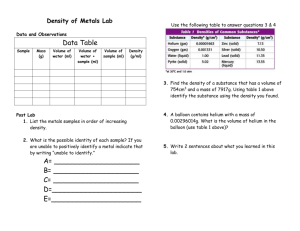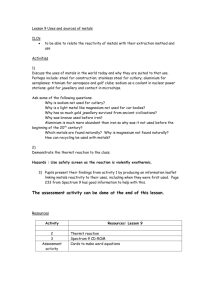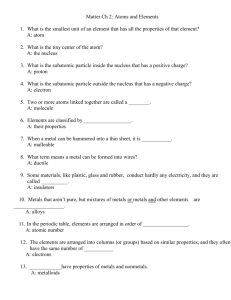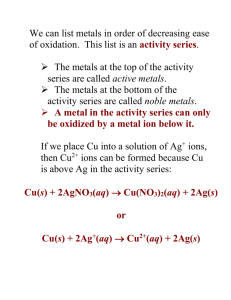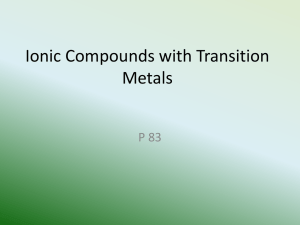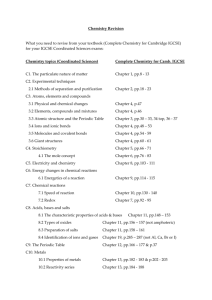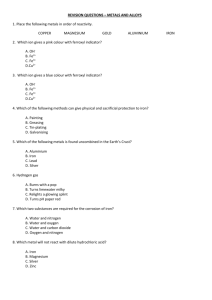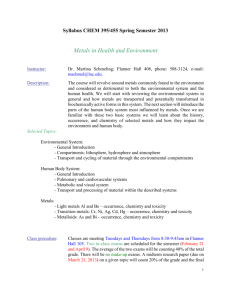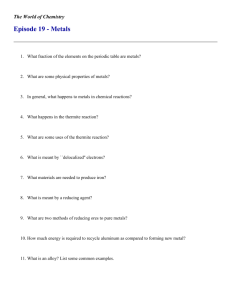2.1.4 Obtaining metals
advertisement
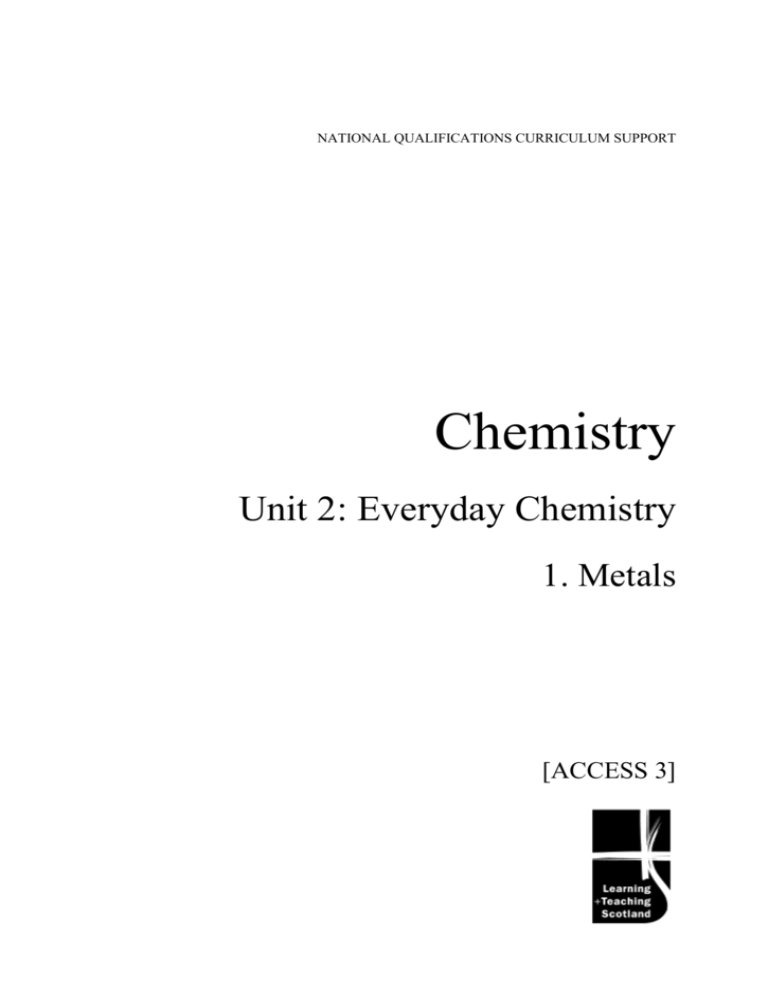
NATIONAL QUALIFICATIONS CURRICULUM SUPPORT Chemistry Unit 2: Everyday Chemistry 1. Metals [ACCESS 3] The Scottish Qualifications Authority regularly reviews the arrangements for National Qualifications. Users of all NQ support materials, whether published by Learning and Teaching Scotland or others, are reminded that it is their responsibility to check that the support materials correspond to the requirements of the current arrangements. Acknowledgement Learning and Teaching Scotland gratefully acknowledges this contribution to the National Qualifications support programme for Chemistry. © Learning and Teaching Scotland 2009 This resource may be reproduced in whole or in part for educational purposes by educational establishments in Scotland provided that no profit accrues at any stage. 2 UNIT 2: EVERYDAY CHEMISTRY – METALS © Learning and Teaching Scotland 2009 Contents Student material 4 Summary notes 48 Revision exercises 53 Revision exercise answers 59 UNIT 2: EVERYDAY CHEMISTRY – METALS © Learning and Teaching Scotland 2009 3 STUDENT MATERIAL Student material 2.1.1 In the Earth’s crust Metallic elements are in green on this periodic table. Uncombined metals Copper, gold and silver are found in the Earth’s crust. They are found as metals alone. Copper Gold Silver Most metals are found combined with other elements in compounds . Compounds which give useful metals are called ores. Iron ore from Atlantic City 4 UNIT 2: EVERYDAY CHEMISTRY – METALS © Learning and Teaching Scotland 2009 STUDENT MATERIAL In pairs, look at the samples of ores on display. Find out which elements are in each ore. Complete Common name of ore Chemical name Symbols for elements present UNIT 2: EVERYDAY CHEMISTRY – METALS © Learning and Teaching Scotland 2009 5 STUDENT MATERIAL 2.1.2 Obtaining metals Heating with carbon Extraction Metals we need for everyday things are made from their ores. Heating ores with carbon can extract metals. The metal oxide is heated with carbon – oxygen combines with carbon to make carbon dioxide. Your teacher will show you how to make a metal from its ore by heating with carbon. Write a word equation for the reaction. ________ +________ ________ + ________ 6 UNIT 2: EVERYDAY CHEMISTRY – METALS © Learning and Teaching Scotland 2009 STUDENT MATERIAL 2.1.3 The blast furnace Iron is one of the most important metals. It is needed to make steel. It is extracted from its ore in a blast furnace. Label the parts of the diagram shown by the dotted line. Use resources to find out about the blast furnace. UNIT 2: EVERYDAY CHEMISTRY – METALS © Learning and Teaching Scotland 2009 7 STUDENT MATERIAL Find out (a) What is loaded in at the top? _________________________________________________ (b) What is produced at the bottom? _________________________________________________ (c) Why is it called a blast furnace? _________________________________________________ _________________________________________________ (d) Complete the word equations for the reactions taking place at A, B and C. A. _________________________________________________ B. _________________________________________________ C. _________________________________________________ 8 UNIT 2: EVERYDAY CHEMISTRY – METALS © Learning and Teaching Scotland 2009 STUDENT MATERIAL 2.1.4 Obtaining metals Using electricity Many metals are taken from the ores by breaking the compound with electricity. Experiment: Breaking up compounds using electricity Set up the circuit as shown. Find out what is formed at the negative electrode. Notes What kind of energy is used to break up the compound? __________________________________________________________ What is formed at the negative electrode? __________________________________________________________ How do you know this? __________________________________________________________ UNIT 2: EVERYDAY CHEMISTRY – METALS © Learning and Teaching Scotland 2009 9 STUDENT MATERIAL Use resources to find out how aluminium is extracted from its ores What I found out... 1. ______________________________________________ ______________________________________________ 2. ______________________________________________ ______________________________________________ 3. ______________________________________________ ______________________________________________ 4. ______________________________________________ ______________________________________________ 10 UNIT 2: EVERYDAY CHEMISTRY – METALS © Learning and Teaching Scotland 2009 STUDENT MATERIAL Complete the sentences using the wordbank and resources. Bauxite is the ore from which most __________ is made. Chemicals made from ______ are used in the papermaking, petroleum, and ________ industries. A white mineral salt called _____, used in drugs and in cosmetics and dyes, also comes from the _____. Aluminium is made from aluminium ______, also called alumina. Aluminium oxide and other aluminium compounds occur in most _________, rocks, and ______. _________ can be made cheaply only from bauxite. aluminium alum minerals bauxite ore soil textile oxide aluminium UNIT 2: EVERYDAY CHEMISTRY – METALS © Learning and Teaching Scotland 2009 11 STUDENT MATERIAL 2.1.5 Properties of metals density Properties thermal conductivity malleability electrical conductivity strength Metals are used for different things, making use of their different properties. Iron is strong Copper is used in wiring Aluminium has low density Watch the investigation your teacher will plan and carry out using metals. 12 UNIT 2: EVERYDAY CHEMISTRY – METALS © Learning and Teaching Scotland 2009 STUDENT MATERIAL 2.1.6 Alloys An alloy is a mixture of metals or a mixture of metals with non-metals. Metals are alloyed to change their properties for specific uses. brass solder ‘stainless’ steel Alloys have important uses. Look at some resources e.g. Books and internet, and find out more about alloys. UNIT 2: EVERYDAY CHEMISTRY – METALS © Learning and Teaching Scotland 2009 13 STUDENT MATERIAL Why are metals alloyed? __________________________________________________________ __________________________________________________________ Fill in the table Uses for alloys Brass 14 Solder UNIT 2: EVERYDAY CHEMISTRY – METALS © Learning and Teaching Scotland 2009 ‘Stainless’ steel STUDENT MATERIAL 2.1.7 Metals and oxygen in the air Reactive metals – metals that react easily with other substances. Unreactive metals – do not react easily with other substances. Metal oxides – metals that combine with oxygen in the air. Your teacher will show you how lithium, potassium and sodium are stored. Fill in A reactive metal is _______________________________________ _______________________________________________________ _______________________________________________________ An unreactive metal is ____________________________________ _______________________________________________________ _______________________________________________________ Which three metals are stored under oil? ________________ + ________________ + ________________ Why are they kept in oil? __________________________________ _______________________________________________________ Are they reactive or unreactive? _____________________________ UNIT 2: EVERYDAY CHEMISTRY – METALS © Learning and Teaching Scotland 2009 15 STUDENT MATERIAL 2.1.8 Heating metals with oxygen Many metals only react with oxygen when heated. Metal oxides are produced in the reactions of metals with oxygen. (a) Fill in Metal When heated with oxygen Magnesium Burns with a bright white flame Tin Aluminium Iron Zinc Copper 16 UNIT 2: EVERYDAY CHEMISTRY – METALS © Learning and Teaching Scotland 2009 STUDENT MATERIAL (b) Give four safety points. Safety in the experiment goggles (c) heat-proof mat hands Place each metal in order of reactivity. least reactive tin Bunsen flame copper most reactive zinc aluminium magnesium UNIT 2: EVERYDAY CHEMISTRY – METALS © Learning and Teaching Scotland 2009 iron 17 STUDENT MATERIAL The word equation for reactions of metals with oxygen is : metal + oxygen metal oxide eg magnesium + oxygen magnesium oxide (d) Write the word equation for the reaction of zinc with oxygen. _________+___________ ______________ copper with oxygen _________+___________ ______________ iron with oxygen _________+___________ ______________ tin with oxygen _________+___________ ______________ aluminium with oxygen _________+___________ ______________ 18 UNIT 2: EVERYDAY CHEMISTRY – METALS © Learning and Teaching Scotland 2009 STUDENT MATERIAL 2.1.9 Metals with water (i) lithium have to be protected from the atmosphere potassium sodium kept covered in oil or they would be dangerous Your teacher will show you the reaction of lithium, potassium and sodium with water. UNIT 2: EVERYDAY CHEMISTRY – METALS © Learning and Teaching Scotland 2009 19 STUDENT MATERIAL You will test the reaction of calcium and iron with water. Results Metal Reaction with water Lithium Potassium Sodium Calcium Iron (b) Put the metals in order of increasing reactivity. least reactive sodium 20 potassium most reactive calcium UNIT 2: EVERYDAY CHEMISTRY – METALS © Learning and Teaching Scotland 2009 iron lithium STUDENT MATERIAL 2.1.10 Testing for hydrogen The gas given off when a metal reacts with water could be hydrogen or oxygen. oxygen relights a glowing splint Carry out this experiment to find a test for hydrogen: Notes (a) Complete the table. What happens when a glowing splint is put into test-tubes with Gas Burning splint Nitrogen Oxygen Hydrogen Carbon dioxide (b) What is the test for hydrogen? ______________________________________________________ UNIT 2: EVERYDAY CHEMISTRY – METALS © Learning and Teaching Scotland 2009 21 STUDENT MATERIAL 2.1.11 Metals with water (ii) A metal which reacts with water forms the metal hydroxide and a gas is given off. The rate of reaction of calcium with water enables the gas to be collected and identified. Your teacher will show you how to identify the gas produced when a metal reacts with water. Fill in (a) What happens when calcium is placed in cold wat er? ______________________________________________________ (b) Which gas is produced when calcium reacts with water? ______________________________________________________ (c) How do you know the gas is present? ______________________________________________________ 22 UNIT 2: EVERYDAY CHEMISTRY – METALS © Learning and Teaching Scotland 2009 STUDENT MATERIAL (d) Write the word equation for the reaction of calcium with water. _________ + _________ _________ + _________ Do the same experiment with magnesium and water. (e) What happens when magnesium is placed in cold water? ______________________________________________________ (f) Put in order of how these react with water: least reactive calcium magnesium most reactive lithium potassium sodium UNIT 2: EVERYDAY CHEMISTRY – METALS © Learning and Teaching Scotland 2009 23 STUDENT MATERIAL 2.1.12 Metals with dilute acid Reactions of metals with an acid make hydrogen gas and a sal t. Some metals react very well with dilute hydrochloric acid. Copper Gold Silver DO NOT REACT Your teacher will show you how to find the gas produced when a metal reacts with: dilute hydrochloric acid dilute sulphuric acid. Method 1. Half fill a test-tube with hydrochloric acid. 2. Add 1 spatulaful of metal. 24 UNIT 2: EVERYDAY CHEMISTRY – METALS © Learning and Teaching Scotland 2009 STUDENT MATERIAL 3. Look and see how well it fizzes. 4. Test the gas given off with a lighted taper – Does it burn with a pop? 5. Do the same for all the metals. 6. Do the same experiment again with sulphuric acid. Fill in your results Reaction with Metal Hydrochloric acid Sulphuric acid Magnesium Iron Zinc Fizzes vigorously Burns with a pop Fizzes fast Taper goes out Fizzes slow Taper relights UNIT 2: EVERYDAY CHEMISTRY – METALS © Learning and Teaching Scotland 2009 25 STUDENT MATERIAL Fill in (a) Which gas is produced when a metal reacts with dilute acid? (b) helium oxygen hydrogen nitrogen. The gas can be identified because it: relights a glowing splint burns with a pop turns limewater milky. (c) Which three metals do not react with dilute acid? ___________ (d) ___________ __________ Complete the word equation for the reaction of magnesium with dilute sulphuric acid. magnesium + ____________ _________ + __________ (e) Complete the word equation for the reaction of zinc with dilute hydrochloric acid. zinc+ ____________ _________ + __________ 26 UNIT 2: EVERYDAY CHEMISTRY – METALS © Learning and Teaching Scotland 2009 STUDENT MATERIAL Metal Reactivity Potassium Most reactive Reaction with Oxygen Lithium Metals which react with dilute acid Metals which react with oxygen Magnesium Dilute acid Metals which react with water Sodium Calcium Water Aluminium Zinc Iron Tin Lead No reaction Copper Mercury Silver No reaction No reaction Gold Least reactive UNIT 2: EVERYDAY CHEMISTRY – METALS © Learning and Teaching Scotland 2009 27 STUDENT MATERIAL Use the table to complete the sentences. (a) The most reactive metal is ________________. (b) The least reactive metal is ________________. (c) A metal which does not react with oxygen is _____________. (d) The five metals which react with water are _____________ _____________ _____________ _____________ _____________ (e) ___________ would not react with hydrochloric acid. 28 UNIT 2: EVERYDAY CHEMISTRY – METALS © Learning and Teaching Scotland 2009 STUDENT MATERIAL Word equations for reactions of metals THINK! A Metal + oxygen metal oxide eg magnesium + oxygen magnesium oxide B Metal + water metal hydroxide + hydrogen eg sodium + water sodium hydroxide + hydrogen C Metal + acid salt + hydrogen What is a salt? This depends on the acid used Acid Salt hydrochloric acid metal chloride sulphuric acid metal sulphate eg calcium + hydrochloric acid calcium chloride + hydrogen iron + sulphuric acid iron sulphate + hydrogen UNIT 2: EVERYDAY CHEMISTRY – METALS © Learning and Teaching Scotland 2009 29 STUDENT MATERIAL Now complete the word equations below. (a) Zinc + oxygen ______________________ (b) Lead + oxygen ______________________ (c) Calcium + water ______________________ (d) Potassium + water ______________________ (e) Magnesium + hydrochloric acid ______________________ (f) Tin + sulphuric acid ______________________ 30 UNIT 2: EVERYDAY CHEMISTRY – METALS © Learning and Teaching Scotland 2009 STUDENT MATERIAL 2.1.13 A problem with metals Corrosion When some metals are left in the open air, they tend to break up at the surface. The metal object gradually disappears as the surface flakes off. The surface changes from an element to a compound. Rusting The corrosion of iron. Iron breaks up and flakes. Iron loses its strength. UNIT 2: EVERYDAY CHEMISTRY – METALS © Learning and Teaching Scotland 2009 31 STUDENT MATERIAL Experiment: What causes rusting? Method 1. 2. 3. Set up three test-tubes as shown above. Leave for three days. Look and see what the metal looks like. Note Note The solubility of air in water decreases the warmer the water gets. Calcium chloride is a drying agent and removes moisture from the air. Boiling water has little dissolved air. Look at the nails and fill in the answers below. 32 UNIT 2: EVERYDAY CHEMISTRY – METALS © Learning and Teaching Scotland 2009 STUDENT MATERIAL Answers (a) In which test-tube does the nail rust? _____ (b) Fill in the words. The ____ in test-tube _ does not rust because the ___ cannot reach the nail. The ____ in test-tube _ does not ____ because the ________ has been removed. nail (c) moisture A rust B air nail Give two things needed for rusting. _____________ _______________ Now check your answers with the person beside you. Can you add anything else? UNIT 2: EVERYDAY CHEMISTRY – METALS © Learning and Teaching Scotland 2009 33 STUDENT MATERIAL 2.1.14 A rust indicator Rust is not an element. When iron rusts the iron atoms become iron ions. A rust indicator is a compound that detects iron ions. Experiment: Finding an indicator for rusting Method 1. Fill a third of each test-tube with iron sulphate. 2. Test-tube 1: add few drops of indicator A. 3. Test-tube 2: add few drops of indicator B. 4. Test-tube 3: add few drops of indicator C. 5. Test-tube 4: add few drops of indicator D. 6. Watch what happens in each test-tube. 34 UNIT 2: EVERYDAY CHEMISTRY – METALS © Learning and Teaching Scotland 2009 STUDENT MATERIAL Fill in your results Indicator Effect on iron sulphate A B C D Notes (a) Which indicator can be used as a rust indicator? A (b) B C D What was the colour change? ______________________________________________________ Now check your answers with the person beside you. Can you add anything else? UNIT 2: EVERYDAY CHEMISTRY – METALS © Learning and Teaching Scotland 2009 35 STUDENT MATERIAL 2.1.15 Speeding up rusting Rust indicator can be used to measure the amount of rusting. The deeper the blue colour, the greater the rusting Notes (a) Use a blue colour to show the amount of rusting in each test-tube. (b) Why do you have the test-tube of pure water? ______________________________________________________ (c) What does acid rain do to the speed of rusting? ______________________________________________________ 36 UNIT 2: EVERYDAY CHEMISTRY – METALS © Learning and Teaching Scotland 2009 STUDENT MATERIAL (d) What does salt do to the speed of rusting? ______________________________________________________ (e) How does putting salt on the roads in winter affect the speed of rusting of a car? ______________________________________________________ (f) Why should you wash your car more often if you live near the sea? ______________________________________________________ (g) Why do cars in the city rust faster than cars in the country? ______________________________________________________ UNIT 2: EVERYDAY CHEMISTRY – METALS © Learning and Teaching Scotland 2009 37 STUDENT MATERIAL 2.1.16 Stopping corrosion (i) In the UK millions of pounds are spent fighting corrosion , eg people will buy a new car because their old one is rusted. Oxygen and water must be present for iron to form rust. Iron can be protected from rusting by stopping air and water coming into contact with the iron. Painting, greasing, tin-plating and coating with plastic form a surface barrier against air and water, providing protection against corrosion. Ways of making a surface barrier to air and water Fill in Ways to protect iron from rusting 1. 2. 3. 4. Which metal is used to galvanise iron? Circle one. lead 38 copper UNIT 2: EVERYDAY CHEMISTRY – METALS © Learning and Teaching Scotland 2009 zinc STUDENT MATERIAL Electroplating Another surface barrier to air and water. Electricity is used to make a thin layer of a new metal, which is less likely to corrode. Covers the metal to be protected. Your teacher will show you how to electroplate a metal . Notes (a) What is meant by electroplating? ______________________________________________________ ______________________________________________________ (b) Why does this protect a metal from corrosion? ______________________________________________________ ______________________________________________________ UNIT 2: EVERYDAY CHEMISTRY – METALS © Learning and Teaching Scotland 2009 39 STUDENT MATERIAL 2.1.17 Stopping corrosion (ii) Iron can also be attached to certain other metals to protect them . This is a very different method to using a surface barrier. Notes (a) Colour the dishes to show the amounts of rusting in each. (b) Look at page 6 in the data booklet. What happens to the speed of rusting when iron is connected to a metal that is more reactive than the iron itself? ______________________________________________________ ______________________________________________________ (c) Why do you think bags of scrap magnesium are attached to underground iron and steel pipes? ______________________________________________________ ______________________________________________________ 40 UNIT 2: EVERYDAY CHEMISTRY – METALS © Learning and Teaching Scotland 2009 STUDENT MATERIAL 2.1.18 Protecting aluminium from corrosion Aluminium is the second most important metal used today. Aluminium is a fairly reactive metal. It needs to be protected. Experiment: Finding out more about aluminium Method 1. Half fill two test-tubes with hydrochloric acid. 2. Put a piece of clean aluminium in one. 3. Put a piece of oxidised aluminium in the other. 4. Add a few drops of detergent to speed up the reaction. 5. Watch what happens. UNIT 2: EVERYDAY CHEMISTRY – METALS © Learning and Teaching Scotland 2009 41 STUDENT MATERIAL Fill in (a) Label the diagram to show the results of the experiment . Aluminium is slow to react since it is usually covered by a thin layer of aluminium oxide. 42 UNIT 2: EVERYDAY CHEMISTRY – METALS © Learning and Teaching Scotland 2009 STUDENT MATERIAL 2.1.19 Batteries Batteries come in all shapes and sizes for different uses. When in use the chemicals in the battery react to make electricity. Chemical energy is changed to electrical energy. When all the chemicals have been used up, the battery can no longer make electricity – the battery is ‘dead’. Some batteries can be recharged, eg the lead–acid battery in a car and nickel– cadmium batteries. These batteries can be used over and over again. Look at the display of batteries. Complete the table. Describe battery What is it used for? UNIT 2: EVERYDAY CHEMISTRY – METALS © Learning and Teaching Scotland 2009 43 STUDENT MATERIAL Fill in (a) Where does the electricity come from in a battery? ______________________________________________________ (b) What energy change takes place? ______________________________________________________ (c) Why do batteries become ‘dead’ after being used for a long time? ______________________________________________________ (d) What is a rechargeable battery? ______________________________________________________ (e) Give two examples of rechargeable batteries. ______________________________________________________ ______________________________________________________ 44 UNIT 2: EVERYDAY CHEMISTRY – METALS © Learning and Teaching Scotland 2009 STUDENT MATERIAL 2.1.20 Making electricity Electricity can be made by connecting different metals to make a cell. A solution with ions is needed to complete the circuit between the metals. Experiment The voltage between different pairs of metals varies. Fill in your results Metal 2 Voltage in volts Magnesium Magnesium Magnesium Magnesium UNIT 2: EVERYDAY CHEMISTRY – METALS © Learning and Teaching Scotland 2009 45 STUDENT MATERIAL Circle the correct answer (a) Magnesium joined to copper/zinc gives the highest voltage. Now look at the reactivity series on page 6 of the data booklet. (b) Metals that are far apart in the reactivity series make a high/low voltage. (c) Magnesium joined to silver will produce a higher/lower voltage than magnesium joined to copper. (d) When zinc is attached to iron, the voltage will be higher/lower than zinc attached to tin. (e) When iron is attached to copper, the voltage will be higher/lower than iron attached to magnesium. Now check your answers with the person beside you. Can you add anything else? 46 UNIT 2: EVERYDAY CHEMISTRY – METALS © Learning and Teaching Scotland 2009 SUMMARY NOTES Summary notes You must know the following to help you in the end of unit assessment. 1. Uses Some metals, including gold, silver and copper, are found unc ombined in the Earth’s crust. Most metals are found combined with other elements. Metal elements and carbon (graphite) are conductors of electricity. Most non-metal elements are non-conductors of electricity. The specific properties of metals are as follows: Properties strength thermal conductivity malleability electrical conductivity 47 UNIT 2: EVERYDAY CHEMISTRY – METALS © Learning and Teaching Scotland 2009 density SUMMARY NOTES Metals are used for different things, making use of their different properties. An alloy is a mixture of metals, or of metals with non -metals. Alloys, including brass, solder and ‘stainless’ steel, have important uses. 48 UNIT 2: EVERYDAY CHEMISTRY – METALS © Learning and Teaching Scotland 2009 SUMMARY NOTES 2. Reactions Reactive metals – metals that react very easily with other substances. Unreactive metals – metals that do not react easily with other substances. Metal oxides – these are formed by metals which combine with the oxygen in the air. Metal What is formed when heated with oxygen Magnesium Magnesium oxide Zinc Zinc oxide Copper Copper oxide Lead Lead oxide Tin Tin oxide Lithium Lithium oxide The reaction of metals with acid often produces hydrogen: Some metals react very well with dilute hydrochloric acid. Copper, silver and gold do not react. Hydrogen is produced when a metal reacts with dilute acid. The test for hydrogen is that it burns with a ‘pop’. UNIT 2: EVERYDAY CHEMISTRY – METALS © Learning and Teaching Scotland 2009 49 SUMMARY NOTES 3. Corrosion When some metals are left in the open air, they tend to break up at the surface. The metal object disappears as the surface flakes off. The surface changes from an element to a compound. Corrosion is a chemical reaction that involves the surface of a metal changing from an element to a compound. Acid rain increases the rate of corrosion. Salt spread on roads increases the rate of corrosion on car bodywork. Painting, greasing, tin-plating and coating with plastic give a surface barrier to air and water that can provide protection against corrosion. Rusting When iron rusts it breaks up and flakes. Iron loses its strength when it rusts. Rusting is the corrosion of iron. Rusting results in a loss of structural strength. Both oxygen (from the air) and water are required for rusting. Rust indicator can be used to show the extent of the rusting process. Rust indicator can be used to measure the amount of rusting. The more blue colour the more rusting. 50 UNIT 2: EVERYDAY CHEMISTRY – METALS © Learning and Teaching Scotland 2009 SUMMARY NOTES 4. Batteries In a battery, electricity comes from a chemical reaction. Batteries require to be replaced due to the chemicals being used up in the reaction. When all the chemicals have been used up, the battery can no longer make electricity – the battery is ‘dead’. Examples of rechargeable batteries include: the lead–acid battery in a car the nickel–cadmium battery in portable radios and personal stereos. These batteries can be used over and over again. UNIT 2: EVERYDAY CHEMISTRY – METALS © Learning and Teaching Scotland 2009 51 REVISION EXERCISES Revision exercises 1. Uses 1. Fill in the missing words. Use the wordbank at the bottom of the page. (a) Some metals, including gold, silver and copper, are found __________ in the Earth’s crust. (b) Most metals are found ________ with other elements. (c) Metal elements and carbon (graphite) are __________ of electricity. (d) Most non-metal ________ are non-conductors of electricity. (e) The use we make of a metal depends on its specific __________. elements properties uncombined 52 UNIT 2: EVERYDAY CHEMISTRY – METALS © Learning and Teaching Scotland 2009 combined conductors REVISION EXERCISES 2. Complete the following sentences by selecting the correct word from the wordbank below. (a) An _____ is a mixture of metals. (b) An alloy can also be a _______ of metals with non-metals. (c) _____ is an alloy. (d) Alloys have important ____. (e) _________ _____ is an alloy. brass alloy mixture 2. Reactions 1. Use arrows to match up the boxes. uses stainless steel reactive Does not react easily with other substances unreactive A few metals which combine with the oxygen in the air metal oxides Metals which react very easily with other substances UNIT 2: EVERYDAY CHEMISTRY – METALS © Learning and Teaching Scotland 2009 53 REVISION EXERCISES 2. Complete the following word equations. tin + oxygen ___ oxide copper + ______ copper oxide ____ + oxygen lead oxide magnesium + oxygen magnesium _____ 3. Answer true (T) or false (F). Copper, silver and gold do not react with acid. Oxygen is produced when metal reacts with dilute acid. All metals react well with dilute hydrochloric acid. The test for hydrogen is that it burns with a pop. Reactions of metals with acid produce hydrogen. 54 UNIT 2: EVERYDAY CHEMISTRY – METALS © Learning and Teaching Scotland 2009 REVISION EXERCISES 3. Corrosion 1. Corrosion is a ________ reaction that involves the _______ of a metal changing from an _______ to a ________. Acid ____ increases the rate of _________. Salt spread on roads increases the rate of _________ on a car’s __________ Painting, ________, tin-plating and coating with plastic give a surface barrier to ___ and _____ which can protect against _________. UNIT 2: EVERYDAY CHEMISTRY – METALS © Learning and Teaching Scotland 2009 55 REVISION EXERCISES Rusting 2. _______ is the corrosion of iron. Rusting results in the loss of structural ________. Oxygen and _____ are needed for rusting. Rust ________ is used to show the extent of rusting. When ____ rusts it breaks and flakes. Iron loses its ________ when it rusts. 56 UNIT 2: EVERYDAY CHEMISTRY – METALS © Learning and Teaching Scotland 2009 REVISION EXERCISES 4. Batteries 1. Chemicals are used up in _________. In a battery, electricity comes from a ________reaction. 2. Two types of rechargeable batteries are: 1. 2. Now look over the summary sheets and study for the assessment. UNIT 2: EVERYDAY CHEMISTRY – METALS © Learning and Teaching Scotland 2009 57 REVISION EXERCISE ANSWERS Revision exercise answers 1. Uses 1. Fill in the missing words. Use the wordbank at the bottom of the page. (a) Some metals, including gold silver and copper, are found uncombined in the Earth’s crust. (b) Most metals are found combined with other elements. (c) Metal elements and carbon (graphite) are conductors of electricity. (d) Most non-metal elements are non-conductors of electricity. (e) The use we make of a metal depends on its specific properties. 2. Complete the following sentences. Select the correct words from the wordbank below. 58 (a) An alloy is a mixture of metals. (b) An alloy can also be a mixture of metals with non-metals. (c) Brass is an alloy. (d) Alloys have important uses. (e) Stainless steel is an alloy. UNIT 2: EVERYDAY CHEMISTRY – METALS © Learning and Teaching Scotland 2009 REVISION EXERCISE ANSWERS 2. Reactions 1. Use arrows to match the boxes. reactive Does not react easily with other substances unreactive A few metals which combine with the oxygen in the air metal oxides Metals which react very easily with other substances 2. Complete the following word equations. tin + oxygen tin oxide copper + oxygen copper oxide lead + oxygen lead oxide magnesium + oxygen magnesium oxide UNIT 2: EVERYDAY CHEMISTRY – METALS © Learning and Teaching Scotland 2009 59 REVISION EXERCISE ANSWERS 3. Answer true (T) or false (F). Copper, silver and gold do not react with acid. T Oxygen is produced when metal reacts with dilute acid. F All metals react well with dilute hydrochloric acid. F The test for hydrogen is that it burns with a pop. T Reactions of metals with acid produce hydrogen. T 60 UNIT 2: EVERYDAY CHEMISTRY – METALS © Learning and Teaching Scotland 2009 REVISION EXERCISE ANSWERS 3. Corrosion 1. Corrosion is a chemical reaction which involves the surface of a metal changing from an element to a compound. Acid rain increases the rate of corrosion. Salt spread on roads increases the rate of corrosion on a car’s bodywork. Painting, greasing, tin-plating and coating with plastic give a surface barrier to air and water that can protect against corrosion. UNIT 2: EVERYDAY CHEMISTRY – METALS © Learning and Teaching Scotland 2009 61 REVISION EXERCISE ANSWERS Rusting 2. Rusting is the corrosion of iron. Rusting results in the loss of structural strength. Oxygen and water are needed for rusting. Rust indicator is used to show the extent of rusting. When iron rusts it breaks and flakes. Iron loses its strength when it rusts. 62 UNIT 2: EVERYDAY CHEMISTRY – METALS © Learning and Teaching Scotland 2009 REVISION EXERCISE ANSWERS 4. Batteries 1. In a battery, electricity comes from a chemical reaction. Chemicals are used up in reactions. 2. Two types of rechargeable batteries are: 1. Lead–acid 2. Nickel– cadmium Now look over the summary sheets and study for the assessment. UNIT 2: EVERYDAY CHEMISTRY – METALS © Learning and Teaching Scotland 2009 63
